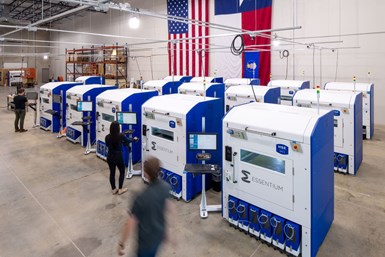Essentium’s EPOD On-Demand Additive Manufacturing Service
Essentium says its Parts On Demand (EPOD) unlocks access to innovative AM technologies to boost speed, scale and cost-efficiency for parts production.
Share
Read Next
Essentium Parts On-Demand (EPOD) is an in-house production service grounded in its High Speed Extrusion (HSE) 3D printing technology. The service offers manufacturers access to Essentium’s engineering expertise and open AM ecosystem of solutions for fast and cost-effective production of parts at scale.
The EPOD service offers customers the benefits of HSE printing and access to Essentium’s entire ecosystem without increasing capital expenditure. With EPOD, customers can use Essentium’s engineering-grade filaments and employ EPOD’s “polymer-to-part” services to make parts from custom filaments formulated and made in-house.
Early customers of the EPOD services are already experiencing benefits. One oil and gas industry customer used HSE printing capability and capacity to print PEEK parts, while an aviation technical operations industry customer utilized the polymer-to-part solution to produce 100-plus housings made of a custom material with flame-resistant properties.
The EPOD service operates nine HSE 3D printers and plans to expand to more than 15 by the end of 2024. It is said the faster printing speeds of HSE printers lead to significant cost advantages for customers compared to other machines. The company says that results from a market survey of more than 40 part production shops worldwide showed that EPOD provides cost benefits for 100% of the geometries and materials surveyed, setting it apart from 13 other industrial extrusion-based service providers.
Joe Anguiano has been appointed as the EPOD sales director to drive growth and customer satisfaction. Before his current role, Joe held senior sales positions within the AM industry. “Ongoing economic and geopolitical turmoil is taking its toll on manufacturers, who have been forced to delay capital expenditure and seek alternative means to procure parts,” Anguiano says. “EPOD services will allow manufacturers to use the HSE platform, including high-performance materials, to produce parts at the right economics without capital investment. Educating new users on AM will also be critical to help them make the leap from prototyping to industrial-scale production. It’s a win-win for manufacturers and the AM industry.”
- Learn more about Essentium’s printer which features an independent dual extrusion system and its PP-CF high-performance material for chemically resistant and low surface energy AM parts.
- Read about Essentium’s PEKK High-Performance Material, which shares most of the performance attributes of PEEK, but has a lower crystallization rate and is less affected by the cooling process once the part is 3D printed, thereby minimizing warping.
Related Content
-
At General Atomics, Do Unmanned Aerial Systems Reveal the Future of Aircraft Manufacturing?
The maker of the Predator and SkyGuardian remote aircraft can implement additive manufacturing more rapidly and widely than the makers of other types of planes. The role of 3D printing in current and future UAS components hints at how far AM can go to save cost and time in aircraft production and design.
-
What Is Neighborhood 91?
With its first building completely occupied, the N91 campus is on its way to becoming an end-to-end ecosystem for production additive manufacturing. Updates from the Pittsburgh initiative.
-
Beehive Industries Is Going Big on Small-Scale Engines Made Through Additive Manufacturing
Backed by decades of experience in both aviation and additive, the company is now laser-focused on a single goal: developing, proving and scaling production of engines providing 5,000 lbs of thrust or less.
















